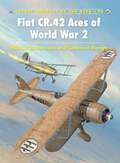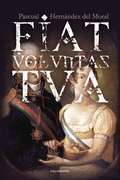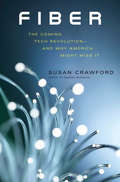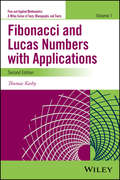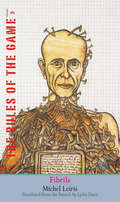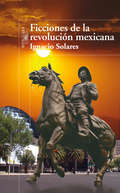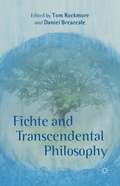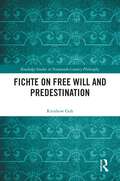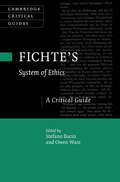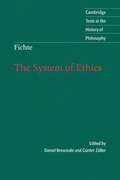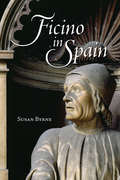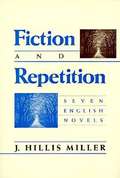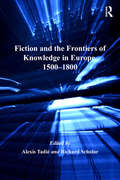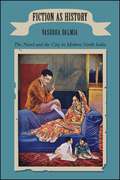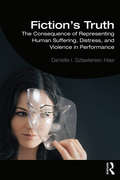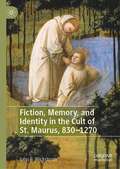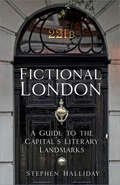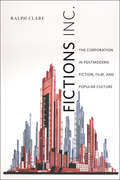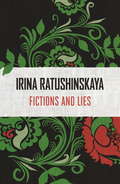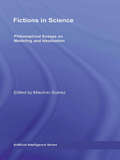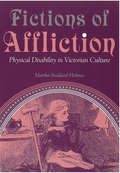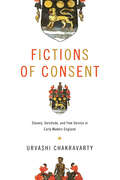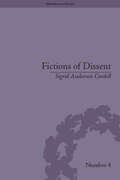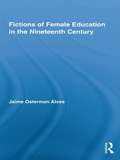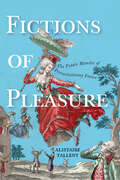- Table View
- List View
Fiat CR.42 Aces of World War 2
by Hakan Gustavsson Richard Caruana Ludovico SlongoThe Fiat CR.42, a logical development of the Fiat CR.32, was the last single-seat fighter biplane to be produced. It entered service with the Italian Regia Aeronautica in May 1939 before being exported to Belgium, Hungary and Sweden. Its combat debut came when the Belgian air force threw its fleet into action during the German invasion of the Low Countries on 10th May 1940. Despite being quickly overwhelmed, the Belgian pilots managed to make a number of aerial claims. The CR.42 became heavily involved in the fighting in North Africa and although it was gradually replaced by more modern fighters, it continued in a point defense and ground support role until the end of the war.Drawing on research from a range of sources, this book examines the extensive employment of the Italian fighter plane during the course of World War II.
Fiat volvntas tva
by Pascual Hernández del Moral«De España, ni buen viento ni buen casamiento.» (Refranero portugués). <P><P>El príncipe Don Juan se prometía la vida plácida de segundón del trono de Portugal. Lo casaron a los quince años con la infanta española Carlota Joaquina de Borbón, de nueve años. La muerte de su hermano mayor y heredero del trono, y la locura de su madre le obligaron a ejercer la regencia de Portugal durante muchos años. <P><P>Sufre una vida conyugal desastrosa debido al genio violento de su esposa y sus ansias de poder, que la llevó a continuas conjuraciones contra él, para apartarlo del poder. De una religiosidad casi supersticiosa, dejaba en las manos de Dios el éxito de las decisiones que debía adoptar, con la frase que da título a la obra: FIAT VOLUNTAS TUA. <P><P>El paso del XVIII al XIX y los cambios sociales, políticos y económicos que sufre Europa, la Revolución Francesa de 1789, la presión de Napoleón y el enfrentamiento de Portugal con Francia y con España, le obliga a trasladar la Corte a Brasil, y establecerse en Río de Janeiro, que es donde se desarrolla la mayor parte de la novela. <P><P>Vuelto a Portugal, siguió sufriendo el acoso de Carlota Joaquina. Tras resolver los muchos problemas políticos, fruto del cambio de los tiempos y de las conjuras permanentes de su esposa, muere tras la independencia de Brasil
Fiber: The Coming Tech Revolution—and Why America Might Miss It
by Susan CrawfordThe world of fiber optic connections reaching neighborhoods, homes, and businesses will represent as great a change from what came before as the advent of electricity. The virtually unlimited amounts of data we’ll be able to send and receive through fiber optic connections will enable a degree of virtual presence that will radically transform health care, education, urban administration and services, agriculture, retail sales, and offices. Yet all of those transformations will pale compared with the innovations and new industries that we can’t even imagine today. In a fascinating account combining policy expertise and compelling on-the-ground reporting, Susan Crawford reveals how the giant corporations that control cable and internet access in the United States use their tremendous lobbying power to tilt the playing field against competition, holding back the infrastructure improvements necessary for the country to move forward. And she shows how a few cities and towns are fighting monopoly power to bring the next technological revolution to their communities.
Fibonacci and Lucas Numbers with Applications, Volume 1
by Thomas KoshyPraise for the First Edition “ …beautiful and well worth the reading … with many exercises and a good bibliography, this book will fascinate both students and teachers.” Mathematics Teacher Fibonacci and Lucas Numbers with Applications, Volume I, Second Edition provides a user-friendly and historical approach to the many fascinating properties of Fibonacci and Lucas numbers, which have intrigued amateurs and professionals for centuries. Offering an in-depth study of the topic, this book includes exciting applications that provide many opportunities to explore and experiment. In addition, the book includes a historical survey of the development of Fibonacci and Lucas numbers, with biographical sketches of important figures in the field. Each chapter features a wealth of examples, as well as numeric and theoretical exercises that avoid using extensive and time-consuming proofs of theorems. The Second Edition offers new opportunities to illustrate and expand on various problem-solving skills and techniques. In addition, the book features: • A clear, comprehensive introduction to one of the most fascinating topics in mathematics, including links to graph theory, matrices, geometry, the stock market, and the Golden Ratio • Abundant examples, exercises, and properties throughout, with a wide range of difficulty and sophistication • Numeric puzzles based on Fibonacci numbers, as well as popular geometric paradoxes, and a glossary of symbols and fundamental properties from the theory of numbers • A wide range of applications in many disciplines, including architecture, biology, chemistry, electrical engineering, physics, physiology, and neurophysiology The Second Edition is appropriate for upper-undergraduate and graduate-level courses on the history of mathematics, combinatorics, and number theory. The book is also a valuable resource for undergraduate research courses, independent study projects, and senior/graduate theses, as well as a useful resource for computer scientists, physicists, biologists, and electrical engineers. Thomas Koshy, PhD, is Professor Emeritus of Mathematics at Framingham State University in Massachusetts and author of several books and numerous articles on mathematics. His work has been recognized by the Association of American Publishers, and he has received many awards, including the Distinguished Faculty of the Year. Dr. Koshy received his PhD in Algebraic Coding Theory from Boston University. “Anyone who loves mathematical puzzles, number theory, and Fibonacci numbers will treasure this book. Dr. Koshy has compiled Fibonacci lore from diverse sources into one understandable and intriguing volume, [interweaving] a historical flavor into an array of applications.” Marjorie Bicknell-Johnson
Fibrils: The Rules of the Game, Volume 3
by Lydia Davis Michel LeirisA major publishing event: the third volume of Michel Leiris's renowned autobiography, now available in English for the first time in a brilliant translation by Lydia Davis A beloved and versatile author and ethnographer, French intellectual Michel Leiris is often ranked in the company of Proust, Gide, Sartre, and Camus, yet his work remains largely unfamiliar to English-language readers. This brilliant translation of Fibrils, the third volume of his monumental autobiographical project The Rules of the Game, invites us to discover why L#65533;vi-Strauss proclaimed him "incontestably one of the greatest writers of the century. " Leiris's autobiographical essay, a thirty-five-year project, is a primary document of the examined life in the twentieth century. In Fibrils, Leiris reconciles literary commitment with social/political engagement. He recounts extensive travel and anthropological work, including a 1955 visit to Mao's China. He also details his suicidal "descent into Hell," when the guilt over an extramarital affair becomes unbearable. A ruthless self-examiner, Leiris seeks to invent a new way of remembering, probe the mechanisms of memory and explore the way a life can be told.
Ficciones de la revolución mexicana
by Ignacio SolaresColección de cuentos en los que pasan Madero, Huerta, Felipe Ángeles, Rodolfo Fierro, Carranza, Obregón, León Toral. La magistral pluma de Ignacio Solares, ganador del Premio Fernando Benítez, nos acerca a un personaje histórico fundamental de México. De Madero y Huerta a Felipe Ángeles y Rodolfo Fierro, pasando por Carranza, Obregón, León Toral y muchos otros personajes, en cada cuento Ignacio Solares inquieta, deslumbra, sorprende a sus lectores con tramas en las que el destino reparte los balazos de manera distinta a la que consignan las versiones oficiales, los hechos ya no coinciden con las efemérides y los infiernos privados abren sus puertas al público, por si hubiera quien se atreva a trasponerlas. Revolución es una palabra que se extingue, dicen. Tiende a entrar en desuso. Sus oxidados bonos van siempre a la baja. Y sin embargo, los sueños que genera siguen teniendo poderes avasalladores y en ellos permanecen vivos los caudillos, los tiranos, la masa anónima que combatió por motivos concretos, o incluso sin ellos, y regó con sangre páginas de la historia y de las historias que integran este volumen. Lo que ha dicho la crítica: "Diecisiete variaciones, invenciones, diecisiete formas de recrear de manera novedosa una historia por demás manoseada. [...]Son cuentos que se dejan leer y proporcionan disfrute al lector". -Fernando García Ramírez, Letras Libres. "Con el humor que lo caracteriza, Ignacio Solares incursiona en el 'hubiera' para contar una historia distinta de Emiliano Zapata en Chinameca; el general Rodolfo Fierro practicaría la compasión humana; el destino de Pino Suárez no hubiera sido tan trágico y las soldaderas hubieran sido fusiladas por el gran adorador de las Mujeres: Pancho Villa".-Yanet Aguilar Sosa, El Universal.
Fichte And Transcendental Philosophy
by Tom Rockmore Daniel BreazealeWith renewed attention to German idealism in general and to Fichte in particular, this timely collection of new papers will be of interest to anyone concerned with transcendental philosophy, German idealism, modern German philosophy and transcendental arguments.
Fichte on Free Will and Predestination (Routledge Studies in Nineteenth-Century Philosophy)
by Kienhow GohThe book explains Fichte’s position on free will and predestination, including its rationale and significance. It argues that Fichte affirms both free will and predestination and explains how he purports to do so without contradiction. The book presents Fichte‘s position as a form of compatibilism that has not yet been explored in the literature. Due to early rationalist convictions, Fichte is as much concerned with reconciling freedom with a logical and a theological determinism as he is with a causal determinism. He sees in Kant’s novel concept of a pure practical reason a new form of rationalism, one consisting of a system of moral rather than natural necessitating grounds. At the same time, he adopts a more radically libertarian stance on free will than Kant. Every member in a sequence of free actions is a “first and absolute member” and could be other than it is given the same antecedent natural events and natural laws. The interest of Fichte as a theorist of freedom lies in how he brings together freedom and predetermination in a way that challenges our assumption about their mutual exclusivity. The book provides an overview of Fichte’s philosophical system—the so-called “Doctrine of Science”—from 1793-1800 with the aim of contextualizing his theory of free agency and destiny. In doing so, it sheds light on how consideration of these issues in turn shapes the system. Fichte on Free Will and Predestination will be of interest to scholars and advanced students working on Fichte’s philosophy, the history of modern philosophy, German Idealism, and the history of the philosophical issue of free will.
Fichte's System of Ethics: A Critical Guide (Cambridge Critical Guides)
by Stefano Bacin Owen WareThe System of Ethics was published at the height of Fichte's academic career and marks the culmination of his philosophical development in Jena. Much more than a treatise on ethics narrowly construed, the System of Ethics presents a unified synthesis of Fichte's core philosophical ideas, including the principle I-hood, self-activity and self-consciousness, and also contains his most detailed treatment of action and agency. This volume brings together an international group of leading scholars on Fichte, and is the first of its kind in English to offer critical and interpretive perspectives on this work, covering topics such as normativity, belief, justification, desire, duty, and the ethical life. It will be an essential guide for scholars wanting to deepen their understanding of Fichte's ethical thought, as well as for those interested in the history of ethics more broadly.
Fichte: The System Of Ethics
by Johann Gottlieb Fichte Daniel Breazeale Guenter ZöllerFichte's System of Ethics, published in 1798, is at once the most accessible presentation of its author's comprehensive philosophical project, The Science of Knowledge or Wissenschaftslehre, and the most important work in moral philosophy written between Kant and Hegel. Fichte's ethics integrates the discussion of our moral duties into the systematic framework of a transcendental theory of the human subject. Its major philosophical themes include the practical nature of self-consciousness, the relation between reason and volition, the essential role of the drives in human willing, the possibility of changing the natural world, the reality of one's own body, the reality of other human beings, and the practical necessity of social relations between human beings. This volume offers a translation of the work together with an introduction that sets it in its philosophical and historical contexts.
Ficino in Spain
by Susan ByrneAs the first translator of Plato's complete works into Latin, the Florentine writer Marsilio Ficino (1433-99) and his blend of Neoplatonic and Hermetic philosophy were fundamental to the intellectual atmosphere of the Renaissance. In Spain, his works were regularly read, quoted, and referenced, at least until the nineteenth century, when literary critics and philosophers wrote him out of the history of early modern Spain.In Ficino in Spain, Susan Byrne uses textual and bibliographic evidence to show the pervasive impact of Ficino's writings and translations on the Spanish Renaissance. Cataloguing everything from specific mentions of his name in major texts to glossed volumes of his works in Spanish libraries, Byrne shows that Spanish writers such as Miguel de Cervantes, Lope de Vega, Bartolomé de las Casas, and Garcilaso de la Vega all responded to Ficino and adapted his imagery for their own works. An important contribution to the study of Spanish literature and culture from the fifteenth to the seventeenth centuries, Ficino in Spain recovers the role that Hermetic and Neoplatonic thought played in the world of Spanish literature.
Fiction and Repetition: Seven English Novels
by J. Hillis Miller<p>In Fiction and Repetition, one of our leading critics and literary theorists offers detailed interpretations of seven novels: Emily Brontë's Wuthering Heights, Thackeray's Henry Esmond, Hardy's Tess of the d'Urbervilles and The Well-Beloved, Conrad's Lord Jim, and Woolf's Mrs. Dalloway and Between the Acts. Miller explores the multifarious ways in which repetition generates meaning in these novels―repetition of images, metaphors, motifs; repetition on a larger scale of episodes, characters, plots; and repetition from one novel to another by the same or different authors. While repetition creates meanings, it also, Miller argues, prevents the identification of a single determinable meaning for any of the novels; rather, the patterns made by the various repetitive sequences offer alternative possibilities of meaning which are incompatible. He thus sees “undecidability” as an inherent feature of the novels discussed. <p>His conclusions make a provocative contribution to current debates about narrative theory and about the principles of literary criticism generally. His book is not a work of theory as such, however, and he avoids the technical terminology dear to many theorists; his book is an attempt to interpret as best he can his chosen texts. Because of his rare critical gifts and his sensitivity to literary values and nuances, his readings send one back to the novels with a new appreciation of their riches and their complexities of form.</p>
Fiction and the Frontiers of Knowledge in Europe, 1500-1800
by Richard Scholar Alexis TadiéThe uses of fiction in early modern Europe are far more varied than is often assumed by those who consider fiction to be synonymous with the novel. The contributors to this volume demonstrate the significant role that fiction plays in early modern European culture, not only in a variety of its literary genres, but also in its formation of philosophical ideas, political theories, and the law. The volume explores these uses of fiction in a series of interrelated case studies, ranging from the Italian Renaissance to the French Revolution and examining the work of, among others, Montaigne, Corneille, Descartes, Hobbes, Locke, and Diderot. It asks: Where does fiction live, and thrive? Under what conditions, and to what ends? It suggests that fiction is best understood not as a genre or a discipline but, instead, as a frontier: one that demarcates literary genres and disciplines of knowledge and which, crucially, allows for the circulation of ideas between them.
Fiction as History: The Novel and the City in Modern North India
by Vasudha DalmiaExplains the Hindi novel's role in anticipating and creating the story of middle-class modernity and modernization in North India.Vasudha Dalmia offers a panoramic view of the intellectual and cultural life of North India over a century, from the aftermath of the 1857 uprising to the end of the Nehruvian era. The North's historical cities, rooted in an Indo-Persianate culture, began changing more slowly than the Presidency towns founded by the British. Dalmia takes up eight canonical Hindi novels set in six of these cities-Agra, Allahabad, Banaras, Delhi, Lahore, and Lucknow-to trace a literary history of domestic and political cataclysms. Her exploration of the emerging Hindu middle classes, changing personal and professional ambitions, and new notions of married life provides a vivid sense of urban modernity. She argues that the radical social transformations associated with post-1857 urban restructuring, and the political flux resulting from social reform, Gandhian nationalism, communalism, Partition, and the Cold War shaped the realm of the intimate as much as the public sphere. Love and friendship, notions of privacy, attitudes to women's work, and relationships within households are among the book's major themes.
Fiction's Truth: The Consequence of Representing Human Suffering, Distress, and Violence in Performance
by Danielle Szlawieniec-HawFiction’s Truth explores professional actors’ lived experiences of representing human suffering, distress, and violence. The book analyses the struggles, issues, and transformations professional actors face when dealing with these portrayals of human life; the personal and interpersonal consequences – both taxing and rewarding – they experience while undertaking these representations; and the forms of attention and care they use to limit the costs and maximize the rewards of their work. The author also includes new key terminology, proposing the term dolesse to capture the experiences of representing human suffering, distress, and violence. Written for entertainment professionals, acting students, and scholars with an interest in acting, theatre, film, and television, Fiction’s Truth addresses the challenges of representing dolesse on stage and in front of the camera, acknowledges the importance of health and wellness in the entertainment industry, and helps remove the stigma that surrounds the consequences these representations often have for actors.
Fiction, Memory, and Identity in the Cult of St. Maurus, 830–1270
by John B. WickstromThis book explores one of the most significant medieval saints’ cults, that of St. Maurus, the first known disciple of Saint Benedict. Despite the centrality of this story to the myth of medieval Benedictine culture, no major scholarly work has been devoted to Maurus since the late nineteenth century. Drawing on memory studies, this book investigates the origins and history of the cult, from the ninth-century Life of St. Maurus by Odo, abbot of Glanfueil, to its appropriation and re-shaping by three powerful abbeys through to the thirteenth century—Fossés, Cluny, and Montecassino. It traces how these institutions deployed caches of mostly forged documents (many translated here for the first time) to adapt the cult to their aspirations and, moreover, considers how the cult adapted itself further, to face the challenges of the modern world.
Fictional London: A Guide to the Capital’s Literary Landmarks
by Stephen Halliday‘By seeing London, I have seen as much of life as the world can show.’ - Samuel JohnsonFrom Chaucer’s pilgrims meeting in a Southwark inn to the Hogwarts Express leaving from King’s Cross, London has always been a popular place for writers to weave into their own work. With its bustling, multicultural population and unique localised weather, the city is almost a character in its own right. Fictional London explores the capital through the eyes of both the reader and the writer. Celebrated London historian Stephen Halliday traces the stories from one end of London to the other, digging into the history and character that has made it an unrivalled source of inspiration for authors and poets from the Middle Ages to the early 2000s and beyond.
Fictions Inc.
by Ralph ClareFictions Inc. explores how depictions of the corporation in American literature, film, and popular culture have changed over time. Beginning with perhaps the most famous depiction of a corporation--Frank Norris's The Octopus--Ralph Clare traces this figure as it shifts from monster to man, from force to "individual," and from American industry to multinational "Other. " Clare examines a variety of texts that span the second half of the twentieth century and beyond, including novels by Thomas Pynchon, William Gaddis, Don DeLillo, Richard Powers, and Joshua Ferris; films such as Network, Ghostbusters, Gung Ho, Office Space, and Michael Clayton; and assorted artifacts of contemporary media such as television's The Office and the comic strips Life Is Hell and Dilbert. Paying particular attention to the rise of neoliberalism, the emergence of biopolitics, and the legal status of "corporate bodies," Fictions Inc. shows that representations of corporations have come to serve, whether directly or indirectly, as symbols for larger economic concerns often too vast or complex to comprehend. Whether demonized or lionized, the corporation embodies American anxieties about these current conditions and ongoing fears about the viability of a capitalist system.
Fictions and Lies
by Irina RatushinskayaIn FICTIONS AND LIES, a writer dies suddenly, in fear of KGB pursuit. His last manuscript, which is thought to be dangerously anti-Soviet, is missing from his apartment, so immediately becomes the object of a rapid police search. As it is traced, whom will it implicate, and what else will it reveal? Deftly, we are led into a world where right and wrong are problematic in ways we never experienced in the West, where integrity and self-respect may prove costly for one's family and friends, where compromise may prove unexpectedly difficult to avoid, and yet where truth and honesty matter all the more for being so elusive.
Fictions in Science: Philosophical Essays on Modeling and Idealization (Routledge Studies in the Philosophy of Science)
by Mauricio SuárezScience is popularly understood as being an ideal of impartial algorithmic objectivity that provides us with a realistic description of the world down to the last detail. The essays collected in this book—written by some of the leading experts in the field—challenge this popular image right at its heart, taking as their starting point that science trades not only in truth, but in fiction, too. With case studies that range from physics to economics and to biology, Fictions in Science reveals that fictions are as ubiquitous in scientific narratives and practice as they are in any other human endeavor, including literature and art. Of course scientific activity, most prominently in the formal sciences, employs logically precise algorithmic thinking. However, the key to the predictive and technological success of the empirical sciences might well lie elsewhere—perhaps even in scientists’ extraordinary creative imagination instead. As these essays demonstrate, within the bounds of what is empirically possible, a scientist’s capacity for invention and creative thinking matches that of any writer or artist.
Fictions of Affliction
by Martha Stoddard Holmes"Highly recommended . . . Holmes moves seamlessly from novelists like Charles Dickens to sociologists like Henry Mayhew to autobiographers like John Kitto. " ---Choice "An absolutely stunning book that will make a significant contribution to both Victorian literary studies and disability studies. " ---Rosemarie Garland-Thomson, Emory University "Establishes that Victorian melodrama informs many of our contemporary notions of disability . . . We have inherited from the Victorians not pandemic disability, but rather the complex of sympathy and fear. " ---Victorian Studies Tiny Tim, Clym Yeobright, Long John Silver---what underlies nineteenth-century British literature's fixation with disability? Melodramatic representations of disability pervaded not only novels, but also doctors' treatises on blindness, educators' arguments for "special" education, and even the writing of disabled people themselves. Drawing on extensive primary research, Martha Stoddard Holmes introduces readers to popular literary and dramatic works that explored culturally risky questions like "can disabled men work?" and "should disabled women have babies?" and makes connections between literary plots and medical, social, and educational debates of the day. Martha Stoddard Holmes is Associate Professor of Literature and Writing Studies at California State University, San Marcos.
Fictions of Consent: Slavery, Servitude, and Free Service in Early Modern England (RaceB4Race: Critical Race Studies of the Premodern)
by Urvashi ChakravartyIn Fictions of Consent Urvashi Chakravarty excavates the ideologies of slavery that took root in early modern England in the period that preceded the development of an organized trade in enslaved persons.Despite the persistent fiction that England was innocent of racialized slavery, Chakravarty argues that we must hold early modern England—and its narratives of exceptional and essential freedom—to account for the frameworks of slavery that it paradoxically but strategically engendered. Slavery was not a foreign or faraway phenomenon, she demonstrates; rather, the ideologies of slavery were seeded in the quotidian spaces of English life and in the everyday contexts of England's service society, from the family to the household, in the theater and, especially, the grammar school classroom, where the legacies of classical slavery and race were inherited and negotiated. The English conscripted the Roman freedman's figurative "stain of slavery" to register an immutable sign of bondage and to secure slavery to epidermal difference, even as early modern frameworks of "volitional service" provided the strategies for later fictions of "happy slavery" in the Atlantic world. Early modern texts presage the heritability of slavery in early America, reveal the embeddedness of slavery within the family, and illuminate the ways in which bloodlines of descent underwrite the racialized futures of enslavement.Fictions of Consent intervenes in a number of areas including early modern literary and cultural studies, premodern critical race studies, the reception of classical antiquity, and the histories of law, education, and labor to uncover the conceptual genealogies of slavery and servitude and to reveal the everyday sites where the foundations of racialized slavery were laid. Although early modern England claimed to have "too pure an Air for Slaves to breathe in," Chakravarty reveals slavery was a quintessentially English phenomenon.
Fictions of Dissent: Reclaiming Authority in Transatlantic Women's Writing of the Late Nineteenth Century (Gender and Genre #4)
by Sigrid Anderson CordellFin-de-siècle fiction by British female aesthetes and American women regionalists stages moments of rebellion when female characters rise up and insist on the right to maintain control of their creations. Cordell asserts that these revolutionary acts constitute a transatlantic conversation about aesthetic practice and creative ownership.
Fictions of Female Education in the Nineteenth Century (Studies in American Popular History and Culture)
by Jaime Osterman AlvesSeeking to understand how literary texts both shaped and reflected the century's debates over adolescent female education, this book examines fictional works and historical documents featuring descriptions of girls' formal educational experiences between the 1810s and the 1890s. Alves argues that the emergence of schoolgirl culture in nineteenth-century America presented significant challenges to subsequent constructions of normative femininity. The trope of the adolescent schoolgirl was a carrier of shifting cultural anxieties about how formal education would disrupt the customary maid-wife-mother cycle and turn young females off to prevailing gender roles. By tracing the figure of the schoolgirl at crossroads between educational and other institutions - in texts written by and about girls from a variety of racial, ethnic, and class backgrounds - this book transcends the limitations of "separate spheres" inquiry and enriches our understanding of how girls negotiated complex gender roles in the nineteenth century.
Fictions of Pleasure: The Putain Memoirs of Prerevolutionary France (EARLY MODERN FEMINISMS)
by Alistaire TallentOut of the libertine literary tradition of eighteenth-century France emerged over a dozen memoir novels of female libertines who eagerly take up sex work as a means of escape from the patriarchal control of fathers and husbands to pursue pleasure, wealth, and personal independence outside the private, domestic sphere. In these anonymously published novels, the heroines proudly declare themselves prostitutes, or putains, and use the desire they arouse, the professional skills they develop, and the network of female friends they create to exploit, humiliate, and financially ruin wealthy and powerful men. In pursuing their desires, the putains challenge contemporary notions of womanhood and expose the injustices of ancien-régime France. Until the French Revolution spelled the end of the genre, these novels proposed not only an appealing libertine utopia in which libertine women enjoy the same benefits as their male counterparts but also entirely new ways of looking at systems of power, gender, and sexuality.
